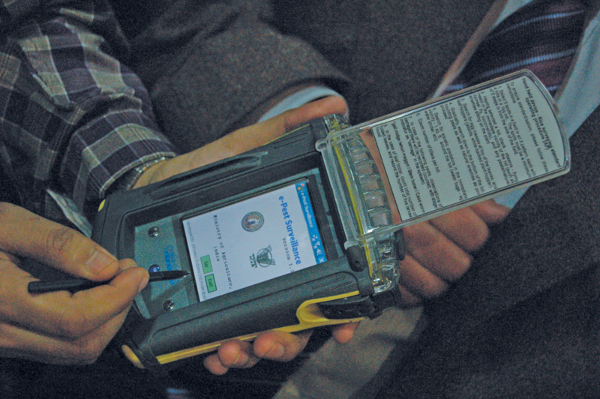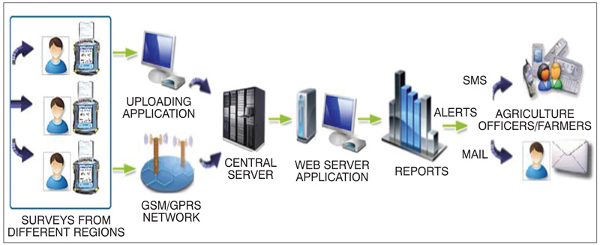
NOVEMBER 2011: In India over 10,000 species of pests destroy food which could feed 135 million people. The current annual loss due to insects, pests and diseases in the agricultural sector is estimated at Rs 150 billion as there are no standard protocols for control of pests, diseases and weeds in the country. In such a scenario, solutions like Fieldman can surely help find a way forward.
Developed by Infronics Systems in association with the Food & Agriculture Organisation (FAO) and Ministry of Agriculture, government of India, Fieldman is an ePest surveillance system. “It offers a uniform and standardised process for pest surveillance and data collection from the agricultural fields to monitor and ascertain the health of the crop, and issue timely advisory to farmers,” reveals M. Chandrashekar, CEO, Infronics Systems.
Technologies that power Fieldman
“Extensive efforts went into conceiving, designing and developing the Fieldman surveillance system. The system is an amalgam of embedded and communication technologies on a single platform. It is designed to operate in extreme external environmental conditions and has been extensively tested (drop tests on concrete and under rain) and certified,” affirms Chandrashekar. There are plug-in sensors for automatic collection of data such as temperature and humidity. The GPS module enables collection of geo-referenced data and the GPRS/GSM module ensures connectivity through the telecom network. The data collected from the fields can be uploaded to a central location for analysis by experts. It is equipped with a rechargeable battery pack to ensure a full day’s field operation.
The ePest surveillance system also includes an extensive suite of software applications—both on the Fieldman handheld system and back-end server—to offer uniform surveillance protocol for field data collection about pests. Experts can analyse the collected data and advisories can be issued to farmers on pest management, enabling them to take preventive steps in time.
The tech challenges

A team of over twelve hardware and software engineers worked continuously for about a year to design and develop the Fieldman ePest surveillance system. Chandrashekar talks about the major challenges that his team encountered and addressed while designing the system hardware: “Incorporating all the modules like GPS, GSM, GPRS and other sensors for data collection along with a touchscreen while meeting the key requirement of making the device rugged enough to operate in extreme environmental conditions was a challenge. On the software front, the major challenge was developing the standard data collection format that would meet the requirements of various stakeholders.”
“The other issue was developing a graphical user-interface (GUI) which would be user-friendly, keeping in mind various operational requirements such as daylight usage, and customising the data for easy field operations, amongst others,” he adds.
The prototype was first tested at various locations in Andhra Pradesh and Kenya under FAO’s supervision. Based on the feedback and test results, necessary modifications and enhancements were done to the system to enable it to meet the user-requirements. “The system has been designed to ensure low cost of ownership and high return on investment,” Chandrashekar affirms.
[stextbox id=”info” caption=”The need for pest surveillance”]
So far the key problems that mar the agricultural sector include lack of standardised methods to gather surveillance data from fields. Another problem is that the field officers appointed by the agricultural departments to report the data from fields often shirk from visiting the fields or report unreliable data. Sometimes the pesticide companies also influence the officers to file an incorrect report to serve their vested interests. As a consequence, agricultural departments are unable to issue reliable advisories to farmers.
Farmers continue to make injudicious use of pesticides, which leads to loss of agricultural yield, increased production cost, and damage to the environment. The agricultural departments are also unable to develop pest-forecasting models and study impact on climate change. Pest surveillance plays an important role in plant-protection and has a direct impact in increasing agricultural yields.
[/stextbox]
How the Fieldman works
The agriculture field officer deputed by the agricultural department surveys the field with the Fieldman handheld device having inbuilt sensors and software. Different types of data (including climatic condition, soil data, temperature, humidity, pests and other information beneficial for crop management) is captured.
This data is transmitted from the field to a central server using GPRS or GSM, or transferred to an Internet-enabled computer through USB cord. The data is stored at the central server and various survey data reports can be generated through its reporting module by picking the data pest-wise, crop-wise and site-wise.
Based on these reports and analysis, agriculture experts can identify the growth of different pests and diseases across regions on various crops and necessary corrective or preventive measures can be taken.






